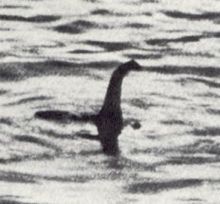 The modern legend of the Loch Ness Monster is born on this date (May 2) when sightings make local news, although accounts of an aquatic beast living in Scotland’s Loch Ness date back to 1,500 years. The newspaper Inverness Courier told the account of a local couple who claimed to have seen “an enormous animal rolling and plunging on the surface.” The newspaper editor used the word “monster” in the story and it immediately became a media phenomenon, with London newspapers sending correspondents to Scotland and a circus offering a 20,000-pound sterling reward for capture of the beast.
The modern legend of the Loch Ness Monster is born on this date (May 2) when sightings make local news, although accounts of an aquatic beast living in Scotland’s Loch Ness date back to 1,500 years. The newspaper Inverness Courier told the account of a local couple who claimed to have seen “an enormous animal rolling and plunging on the surface.” The newspaper editor used the word “monster” in the story and it immediately became a media phenomenon, with London newspapers sending correspondents to Scotland and a circus offering a 20,000-pound sterling reward for capture of the beast.
As I read about this story I found myself looking for an “interest angle” and discovered it along with other facts. Loch Ness, located in Scottish Highland, has the largest volume of water in Great Britain; the body of water reaches a depth of nearly 800 feet and a length of about 23 miles. Scholars of the Loch Ness Monster find a dozen references to “Nessie” in Scottish history, dating back to around A.D. 500, when local Picts (the name given to mysterious race of people who occupied the northern regions of Scotland as early as the fourth century A.D.) carved a strange aquatic creature into standing stones near Loch Ness.
The earliest written reference to a monster in Loch Ness is a 7th-century biography of Saint Columba, the Irish missionary who introduced Christianity to Scotland. In 565, according to the biographer, Columba was on his way to visit the king of the northern Picts near Inverness when he stopped at Loch Ness to confront a beast about to attack another man, Columba intervened, invoking the name of God and commanding the creature to “go back with all speed.” The monster retreated and never killed another person.
Legends aside, Saint Columba, like all of us, had to face his doubts and fears and in this case, found the best possible results. Simple, right? Hardly. Doubts and fears in legend and life tests even the strongest.
My conversation this week with a friend whose faith I always considered strong startled me. We had met about a “non-faith” issue, but when faith surfaced he honestly stated he was in a “radical doubt” phase of his life. As we talked, I began to see the puzzle pieces of his doubt. Seminary trained, he had left the “professional” ministry decades ago, but had remained faithful and committed to the local church. Life, however, etched shadows of suspicion and before he realized, his doubt shifted from marginal to major.
As we parted, agreeing to meet again to talk about faith issues, I found myself remembering another doubter by the name of Thomas. Personally, I have always admired Thomas’ honesty both in his journey as well as his destination.
Dorothy Sayers, in her book, The Man Born to Be King, said it best: “It is unexpected, but extraordinarily convincing, that the one absolutely unequivocal statement in the whole gospel of the Divinity of Jesus should come from Doubting Thomas. It is the only place where the word God is used … without qualification of any kind, and in the most unambiguous form of words …. And this must be said — not ecstatically, or with a cry of astonishment — but with flat conviction, as of one acknowledging irrefragable evidence: ‘2 + 2 = 4,’ ‘That is the sun in the sky,’ ‘You are my Lord and my God!’”
No, I don’t believe in Loch Ness monsters, but I do believe in the honest, confession of seekers with radical doubt. Every day I live I wrestle with some level of doubt and certainty. Certainty wins more often than not, but I believe it is my honest journey with doubt that allows me to face the faithless monsters of my life with that determined declaration: “go back with all speed.”